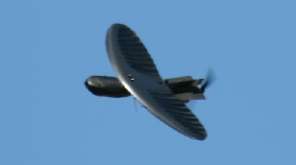Prioria Robotics Maveric
The Prioria Robotics Maveric is a discontinued unmanned aerial vehicle (UAV) marketed as a high-performance, next-generation platform for small and miniature UAV operations. Maveric's bendable wings allow for the ability to store a fully assembled airframe in a 6-inch (150 mm) tube. Maveric pricing was wholly dependent on configuration, and an advanced military system configuration cost between $100,000 and $200,000.[1]
| Prioria Maveric | |
|---|---|
 | |
| Maveric UAV in Flight | |
| Role | Tactical, Squad-level, Hand-launched |
| Manufacturer | Prioria Robotics, Inc. |
Design
Maveric can be deployed immediately with no assembly,[2] with a claimed dash speed of 55 knots (63 mph; 102 km/h).[1] Marketed as the first smart, customizable SUAS, Maveric utilizes Prioria's proprietary processing platform, Merlin.[2]
Operation
Maveric is capable of fully autonomous operation from launch to landing using waypoints,[2] or it can be flown manually by a human pilot via a simple joystick under autopilot assistance.[3]
Maveric was designed for operation by a single user in a military, tactical setting. To accomplish this goal, the airframe had to be small and light enough (2 lb) for a single user to transport, but with large enough wings (28 in) to support the weight of the batteries, cameras, and electronics sufficient for up to one hour of flight-time.[3]
To overcome issues of portability and assembly time, designers employed a bendable-wing design. This design allows for Maveric's wings, which are large enough to meet the desired operational requirements to collapse and wrap around its fuselage and be placed in a 6-inch-diameter (150 mm) tube, while remaining in a fully assembled state. This has two advantages. It allows the aircraft to be stored in a small space, and it makes the aircraft capable of immediate launch on removal from storage. The flexible wings were also claimed to produce a dampening effect called "apative washout" that would allow the UAS to be flown in heavy wind gusts.[2]
The bendable wings and bird-like profile were also claimed to produce an effect of biological camouflage.[4]
Legal scandal
In 2013, Condor Aerial entered a contract to become a licensed retailer of the Maveric system. While Prioria would handle defense contracts itself, Condor would have the right to sell the product to local law enforcement agencies. However, after Condor founder Fred Culbertson advocated for use of the Maveric to the Monroe, North Carolina City Council, it was revealed that he had served time in prison for obtaining property by false pretenses. The City Council cited concern over Culbertson's criminal record, as well as upcoming legislation and negative public response, in their unanimous decision to halt discussions of purchasing drones for use by local law enforcement.[5]
Condor later accused Prioria of providing false specifications for the drone, and therefore selling it a hobby-grade drone at a military-grade price.[4] The complaint included allegations that the drone was easily damaged.[6] This claim ran counter to a report by NOAA, which documented their own Maveric drones lasting over six years without mechanical incident over the course of 4,500 combined sorties.[7] Condor also alleged that Prioria failed to return a Maveric sent to them for repairs, which financially crippled Condor.[6]
In spite of Condor's allegations that the Maveric was a hobby drone being sold to the military at an exorbitant price, Prioria secured a $4.5 million contract with the Defense Logistics Agency to provide Maveric drones to the United States Army, Navy, Air Force, and NASA at $240,000 each.[4] Prioria also secured a 2017 Department of Defense contract to provide an armed UAVs to the Army.[8]
The Condor Aerial lawsuit resulted in a court-ordered seizure of Prioria's assets in January, 2018. After the seizure was carried out by law enforcement, the company went into insolvency.[9][10][11]
Former operators

.svg.png)

See also
- Unmanned Aerial Vehicle (UAV)
- Miniature UAV
- Micro Air Vehicle (MAV)
- History of unmanned aerial vehicles
References
- "US Army equipping soldiers with fleet of bird-like drones". RT USA. November 27, 2013. Retrieved November 8, 2019.
- "Maveric Mini Unmanned Aerial System (MUAS)". AirForce Technology. Verdict Media Unlimited. Retrieved November 8, 2019.
- Crane, David (May 23, 2011). "Prioria Robitics Maveric Flexible-Wing Mini-UAS". Defense Review. DefenseReview.com. Retrieved November 8, 2019.
- Musgrave, Shawn (November 3, 2015). "Drone Company Misled Military into Buying UAVs that Were Basically Toys: Lawsuit". Vice. Retrieved November 8, 2019.
- Bell, Adam (March 28, 2013). "Monroe abandons drone project". The Charlotte Observer. Retrieved November 18, 2019.
- Caplan, Andrew; Strange, Deborah (January 20, 2018). "Assets seized at Prioria Robotics". The Gainesville Sun. Retrieved November 8, 2019.
- Zarzar, Chris; Moorhead, Robert; Coffey, John (September 15, 2014). "NOAA 2nd UAS Arctic River Forecasting Workshop 2014" (PDF). NOAA.gov. p. 43. Retrieved November 20, 2019.
- "Cluster UAS Smart Munition for Missile Deployment - "Killer Bees"". SBIR.gov. Retrieved November 20, 2019.
- "Prioria Robotics Holdings, Inc. Bankruptcy (1:18-bk-10019), Florida Northern Bankruptcy Court". www.pacermonitor.com. Retrieved 2019-11-07.
- Caplan, Andrew. "Prioria Robotics complainant calls for criminal charges". gainesville.com. The Gainesville Sun. Retrieved 18 July 2019.
- Musgrave, Shawn (2015-11-03). "Drone Company Misled Military into Buying UAVs that Were Basically Toys: Lawsuit". Vice. Retrieved 2019-11-07.
- United States Army purchases Maveric bird camouflage UAS Archived 2013-12-03 at the Wayback Machine - Armyrecognition.com, 26 November 2013